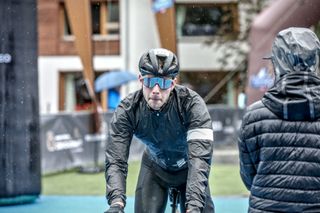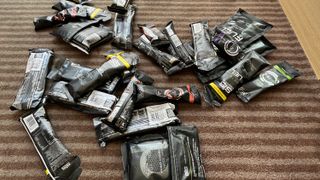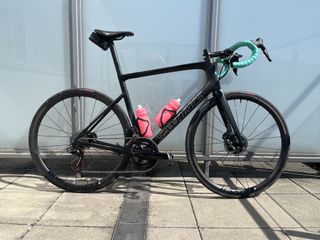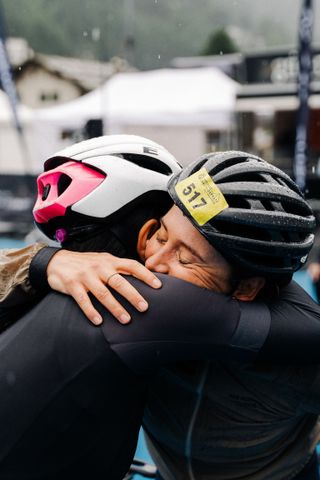Six things I learned on my hardest ever ride
Chasing Cancellara took me on a 275km journey with 6000m of climbing. Here are some of the things I learned along the way

Last week I was lucky enough to go to Switzerland to ride the Chasing Cancellara Zurich-Zermatt ultra fondo. At 275km long, with two mountain passes and a third mountain-sized ascent to the finish in the Alpine ski resort of Zermatt, it was the longest, and by far the hardest, challenge I'd faced on two wheels.
Naturally, such is the way when pushing oneself to new boundaries, things are learned. Some of those were simple mistakes that, while I've undoubtedly learned from, will probably be replaced with others in future. Forgetting to pack a towel for the finish line was a new one, alongside loading the route before starting the ride, or making a note of how much I'd eaten so I didn't need to try and remember.
They're not the lessons that resonate in my mind as I write this article though, nor are they the ones that will stick with me. There are more pertinent lessons that I think are worth sharing, and below, I've done jus that.
It's all in your head
With 260km done, I was starting to crack. I had earlier forgotten to resume my Wahoo at the top of the route's highest point, and the error had gone unnoticed when I eventually did so at the following checkpoint 20km later, so for this latter section of the ride, my computer told me I had 35km to go, despite having received confirmation from a marshall that there was 15km to go. Confusion started to creep in. Had they cut the route short? Had I somehow gone the wrong way and made it back to the course without noticing?
The road had been rising for around 15km already. These weren't the tight, narrow mountain pass seemingly reserved for bikes and supercars that I had encountered earlier on the Grimselpass, but a main road peppered with construction lorries and Audi drivers who'd probably grown frustrated at having already passed 50 weary pedallers on their way to buzzing past me, each at what felt like a distance of six inches.
The headwind blew, and I was crawling. The climb was inconsistent, ramps of up to 12% were followed by short, shallower descents and I couldn't get into a rhythm. At one point, I hopped onto the pavement to evade the stream of traffic coming by. "I'm a pedestrian now," I muttered aloud.
The spots of rain soon turned into an opening of the heavens and the 80-metre distance between me and the entrance to the next tunnel was too far to bear. I pulled over to a stop and wearily peeled the Rapha Shakedry jacket from my pocket.
Get The Leadout Newsletter
The latest race content, interviews, features, reviews and expert buying guides, direct to your inbox!
I was certain I had hit the wall. My nutrition plan had gone a little awry with palate fatigue and the aforementioned failure to keep note. Nothing was particularly in pain, but everything felt empty. I was in unchartered territory having never ridden further than 250km, and any desire to keep up with competitors was gone. By hook or crook, I needed to just get to the finish.
I trundled on, wondering if I even liked cycling anymore, but then I arrived in Tasch, the final checkpoint at 270km. I stopped, I said hello and thank you to the volunteer helper braving the rain so that foolish people like me can do things like this. "Just 5km to go," she said before laughing at the grimace I returned.
I was on the home stretch and I knew it was almost done. Somehow the earlier trundle turned into a driven push, and the competitive motivation had returned as I caught and passed a couple of others.
I hadn't hit the wall at all, I had just cracked. It was all in my head.

Palate fatigue is real, even if it's also in my head
I have a sweet tooth, that much is sure. I'll happily bury a Nutella sandwich or drop a dollop of Biscoff spread in a bowl of porridge. I also consider myself very adept at consuming high quantities of carbohydrates - ie sugary drinks - on the bike. 90 grams per hour is the accepted maximum amount that a human can process (assuming appropriate ratio of glucose and fructose), with research suggesting more is doable. I can comfortably ingest 100 grams with no stomach problems or indigestion. But after consuming sugary drinks, bars and gels for 10 hours, I wanted nothing less than another, even though I knew I needed to continue fuelling.
I pushed through, but palate fatigue is real, even if that too is only real in my head. Tips on overcoming this will be gratefully received.
I don't need to sleep as much as I thought
I am one of those annoying people who can sleep like a log. According to my Whoop account, the number of minutes it takes me to fall asleep is between seven and 14. Because of this, if I don't get enough, I think the world is ending. I'm lethargic, I'm demotivated, I'm probably no fun to be around. Having a Whoop strap that helps me monitor it is probably as much a curse as it is a blessing, but I'm glad I have it, because throughout my time in Switzerland, I learned that I can actually function just fine without my oh-so-important eight hours.
The ride started at 1:30am, so I had my alarm set for 00:30am. The night before, I went to bed at 8pm. Bear in mind that with Switzerland being one hour ahead of the UK, this was like trying to go to bed at 7pm: much earlier than my usual 11pm lights-out. My circadian rhythm wasn't going to play ball, and my impressive sleep latency was nowhere to be seen as I lay awake for over two hours. According to my Whoop, I managed 1h44m asleep in total. Fabian Cancellara had himself earlier told me that the big challenge is riding through the night and that 7am was the first finish line. Despite this, I was fine. Wide awake in fact. Save for the darkness, it could have been midday.
Fast forward to my return to Zurich at 00:30 the following morning, I had been awake for 24 hours straight and was still present enough to re-pack my bike into the bike box and pack my bags ahead of another early start to catch my flight home.
Don't get me wrong, I still understand that sleep is important, and this isn't in any way a recommendation to go and pull an all-nighter before your big event, but I might stop moaning that I'm tired all the time.

Bike tech is really good nowadays
I chose to ride an S-Works Tarmac SL6 that I bought four years ago before joining Cyclingnews. It's my best road bike, and it's become a bit of a test mule for the latest products that may or may not be included in our buyer's guides. It's never let me down, and it continues to impress.
Don't get me wrong, 275km of road riding should be easy for a bike that once had an RRP of £9k, but even so, after four years, it still rides and looks like it's brand new and performed flawlessly. The Roval Alpinist CLX II wheels were an upgrade specifically for this event and paired with the S-Works Turbo RapidAir tyres, punctures were kept at bay with a total lack of any drama.
The PRO Stealth Curved saddle has been my saddle of choice since I first tried it back in spring, and it passed this test - by far its longest test - with flying colours. The Wahoo Elemnt Bolt survived more than 13 hours of turn-by-turn directions, paired with a power meter, heart rate monitor, and Core temperature sensor, as well as having its backlight on for much of the night. It had 7% battery remaining, but even as I slogged up the final mountain, I didn't doubt it would survive.
The Exposure Strada MK11 SB was bright enough - and the early terrain steady enough - that it spent most of the night on its low setting, but the first time I switched it to high power, I literally laughed aloud in disbelief at just how bright it was.
My Bont Vaypor S shoes went totally unnoticed for the whole ride, which is exactly what I needed from them, and my Rapha Shakedry jacket and Sportful NoRain gilet kept me from freezing as I descended from the route's highest point for 10km straight.
In fact, every piece of kit I used performed exactly as it should have, and that's both a reflection of those individual items, but also cycling tech as a whole nowadays. Stay tuned for a more detailed rundown of my tech choices later this week.
A scary challenge focuses the mind
For a couple of years now, my cycling goals have been 'get fit for summer, and maybe I'll do some races'. The problem is, that isn't very 'smart'. It's certainly not specific, it's only loosely measurable, and while it's achievable and relevant, I'm never particularly specific with the timing.
Unsurprisingly, it hasn't really worked to motivate me each day. I ride enough, I'm generally fit enough to get around a regional level race, but I'm never at the pointy end and therefore never very happy.
Having the Chasing Cancellara event as a goal ahead of me was transformative for my dedication and motivation. I suddenly had a goal, a deadline and a reason to train, as well as a stark understanding of just how much harder the day would be if I didn't.
I enjoyed the preparation just as much as the event itself, and now that it's over, I'm already working out what my next big goal should be.

A bike ride can be more than just a bike ride
This was the biggest challenge I'd faced on a bike, and while I was confident that I could do it, I am nonetheless happy that I did. However for some, this was more than just a big day out riding bikes, it was a challenge the size of the Matterhorn peak that towered over us at the finish in Zermatt.
From the mother waiting at the finish complete with Find My open on her iPhone watching her son roll up the final mountain, to the trio of guys who'd leapfrogged me up the Grimselpass 150km earlier who then raised a beer in recognition and acknowledgement of our collective achievements, the pride at that finish line was like nothing I've ever seen.
Joy, relief and often disbelief etched itself across riders' faces as they crossed the finish line all afternoon, accompanied by copious camaraderie between people who until today had never met. To everyone there, this was more than just a day in the saddle, it was that mind-focussing scary goal that they had succeeded at overcoming.
There were a lot of empty legs at the finish line, but there were just as many full hearts.

Thank you for reading 5 articles in the past 30 days*
Join now for unlimited access
Enjoy your first month for just £1 / $1 / €1
*Read any 5 articles for free in each 30-day period, this automatically resets
After your trial you will be billed £4.99 $7.99 €5.99 per month, cancel anytime. Or sign up for one year for just £49 $79 €59

Join now for unlimited access
Try your first month for just £1 / $1 / €1

Josh is Associate Editor of Cyclingnews – leading our content on the best bikes, kit and the latest breaking tech stories from the pro peloton. He has been with us since the summer of 2019 and throughout that time he's covered everything from buyer's guides and deals to the latest tech news and reviews.
On the bike, Josh has been riding and racing for over 15 years. He started out racing cross country in his teens back when 26-inch wheels and triple chainsets were still mainstream, but he found favour in road racing in his early 20s, racing at a local and national level for Somerset-based Team Tor 2000. These days he rides indoors for convenience and fitness, and outdoors for fun on road, gravel, 'cross and cross-country bikes, the latter usually with his two dogs in tow.
Most Popular

